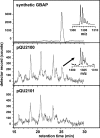Revised model for Enterococcus faecalis fsr quorum-sensing system: the small open reading frame fsrD encodes the gelatinase biosynthesis-activating pheromone propeptide corresponding to staphylococcal agrd
- PMID: 16980448
- PMCID: PMC1698201
- DOI: 10.1128/JB.00865-06
Revised model for Enterococcus faecalis fsr quorum-sensing system: the small open reading frame fsrD encodes the gelatinase biosynthesis-activating pheromone propeptide corresponding to staphylococcal agrd
Abstract
Gelatinase biosynthesis-activating pheromone (GBAP) is an autoinducing peptide involved in Enterococcus faecalis fsr quorum sensing, and its 11-amino-acid sequence has been identified in the C-terminal region of the 242-residue deduced fsrB product (J. Nakayama et al., Mol. Microbiol. 41:145-154, 2001). In this study, however, we demonstrated the existence of fsrD, encoding the GBAP propeptide, which is in frame with fsrB but is translated independently of fsrB. It was also demonstrated that FsrB', an FsrD segment-truncated FsrB, functions as a cysteine protease-like processing enzyme to generate GBAP from FsrD. This revised model is consistent with the staphylococcal agr system.
Figures





Similar articles
-
Siamycin attenuates fsr quorum sensing mediated by a gelatinase biosynthesis-activating pheromone in Enterococcus faecalis.J Bacteriol. 2007 Feb;189(4):1358-65. doi: 10.1128/JB.00969-06. Epub 2006 Oct 27. J Bacteriol. 2007. PMID: 17071762 Free PMC article.
-
The gelatinase biosynthesis-activating pheromone binds and stabilises the FsrB membrane protein in Enterococcus faecalis quorum sensing.FEBS Lett. 2020 Feb;594(3):553-563. doi: 10.1002/1873-3468.13634. Epub 2019 Oct 21. FEBS Lett. 2020. PMID: 31598959 Free PMC article.
-
Gelatinase biosynthesis-activating pheromone: a peptide lactone that mediates a quorum sensing in Enterococcus faecalis.Mol Microbiol. 2001 Jul;41(1):145-54. doi: 10.1046/j.1365-2958.2001.02486.x. Mol Microbiol. 2001. PMID: 11454207
-
Properties of Enterococcus faecalis plasmid pAD1, a member of a widely disseminated family of pheromone-responding, conjugative, virulence elements encoding cytolysin.Plasmid. 2007 Nov;58(3):205-27. doi: 10.1016/j.plasmid.2007.05.001. Epub 2007 Jun 27. Plasmid. 2007. PMID: 17590438 Review.
-
Sex pheromones and gene transfer in Enterococcus faecalis.Res Microbiol. 2000 Jul-Aug;151(6):493-6. doi: 10.1016/s0923-2508(00)00163-7. Res Microbiol. 2000. PMID: 10961465 Review.
Cited by
-
Allele-dependent differences in quorum-sensing dynamics result in variant expression of virulence genes in Staphylococcus aureus.J Bacteriol. 2012 Jun;194(11):2854-64. doi: 10.1128/JB.06685-11. Epub 2012 Mar 30. J Bacteriol. 2012. PMID: 22467783 Free PMC article.
-
Mechanism of Action of Ribosomally Synthesized and Post-Translationally Modified Peptides.Chem Rev. 2022 Sep 28;122(18):14722-14814. doi: 10.1021/acs.chemrev.2c00210. Epub 2022 Sep 1. Chem Rev. 2022. PMID: 36049139 Free PMC article. Review.
-
Siamycin attenuates fsr quorum sensing mediated by a gelatinase biosynthesis-activating pheromone in Enterococcus faecalis.J Bacteriol. 2007 Feb;189(4):1358-65. doi: 10.1128/JB.00969-06. Epub 2006 Oct 27. J Bacteriol. 2007. PMID: 17071762 Free PMC article.
-
Enterococcus infection biology: lessons from invertebrate host models.J Microbiol. 2014 Mar;52(3):200-10. doi: 10.1007/s12275-014-4011-6. Epub 2014 Mar 1. J Microbiol. 2014. PMID: 24585051 Free PMC article. Review.
-
Structure-activity relationship of gelatinase biosynthesis-activating pheromone of Enterococcus faecalis.J Bacteriol. 2009 Jan;191(2):641-50. doi: 10.1128/JB.01029-08. Epub 2008 Nov 7. J Bacteriol. 2009. PMID: 18996993 Free PMC article.
References
-
- Benhar, I., C. Miller, and H. Engelberg-Kulka. 1992. Frameshifting in the expression of the Escherichia coli trpR gene. Mol. Microbiol. 6:2777-2784. - PubMed
-
- Bourgogne, A., S. G. Hilsenbeck, G. M. Dunny, and B. E. Murray. 2006. Comparison of OG1RF and an isogenic fsrB deletion mutant by transcriptional analysis: the Fsr system of Enterococcus faecalis is more than the activator of gelatinase and serine protease. J. Bacteriol. 188:2875-2884. - PMC - PubMed
-
- Cruz-Rodz, A. L., and M. S. Gilmore. 1990. High efficiency introduction of plasmid DNA into glycine treated Enterococcus faecalis by electroporation. Mol. Gen. Genet. 224:152-154. - PubMed
-
- Cserzo, M., E. Wallin, I. Simon, G. von Heijne, and A. Elofsson. 1997. Prediction of transmembrane alpha-helices in prokaryotic membrane proteins: the dense alignment surface method. Protein Eng. 10:673-676. - PubMed
Publication types
MeSH terms
Substances
LinkOut - more resources
Full Text Sources
Other Literature Sources
Molecular Biology Databases

